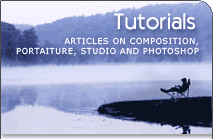Photography Tutorials
Three Main Rules
 (29)
(29) 
By reading this article you will learn how to create a photograph (in general terms). There are three main things: theme, focusing attention and simplicity. You will find out what those things mean to you and to the photograph.
Black & White Photography
 (10)
(10) 
This page expresses my feelings and thoughts on Black & White photography after reading the series of books "Better Picture Guide to...". Of course, this is my perspective on this subject - more like a reaction to the reading. The page covers the facets of Black & White photography, such as Light and Form, Texture, Shapes and Forms, Mood and etc.
Composing The Frame
 (36)
(36) 
In this article I will try to describe numerous techniques to compose a good picture. Some of these techniques are well known (e.g. rule of thirds), some based on graphics of design and painting. I consider the techniques as jongleur balls. The more balls you hold in air (handle), the better pictures you create.
How To Critique Photographs
 (5)
(5) 
One would think that the concept of critiquing photographs is simple - a photographer submits his or her prints to a competition or a "judge" or judging panel, ostensibly of his or her peers or perhaps a person or persons of a known quantity of higher expertise, for the purposes of constructive criticism or for validation of their existing skills and talents. However there is more to it and this article explains that.
Graphics In Photography
 (70)
(70) 
In this article I want to tell about graphic elements in a photograph and how and what effect they bring. The composition of a photograph, as I see it, has most important meaning and effect on the final result and impression. The graphical elements are the bricks of the composition.
More About Light
 (5)
(5) 
In this article Ed covers several issues and opportunities, which we encounter when doing portraiture outdoors in various lighting conditions. As well you will find out what equipment to use in such situations.
Weather and Time of Day
 (4)
(4) 
We, photographers, go out and make photographs in different times of day or weather conditions. Most people incline to go shooting when it is sunny and warm, but what about other times? On this page I will try to explain how the weather conditions and time of the day affect the photograph and the ways we can take advantage of such situations.
Deep Within
 (37)
(37) 
I was planning to write this article for quite a while. It's not like one of the previous ones, which you can find on my website. Those articles tell you about technicalities and what I call the language of photography - the composition. It always assumed that if people know the language they can speak. Yes, they can, but could they be eloquent and articulate? Not always, though such qualities may come with time and some practice. However this article not even about eloquence, it is about what gives birth to the mastery and what lies deep within each of us - impression.
Long Exposure
 (58)
(58) 
Usually the photographs we take have very short shutter speeds - fractions of a second. And there are a lot of articles about such photographs. However when you step into the realm of long exposures, you find many interesting things and effects. In this article I will try to explain several known to me techniques that relate to usage of long exposures.
F.R.E.E. Photography (part 1 - Feel)
 (20)
(20) 
This is the first article (Feel) in the series where I present you a roadmap of a photographer: Feel, Reflect, Execute and Enhance (FREE). As I see it, there are these four stages that the master photographer has to go through in order to achieve a great photograph. In our busy and hasty age (the digital one) people who like photography usually go through one or two of these stages. But I feel that without walking the path from the beginning to the end we will not achieve great results.
F.R.E.E. Photography (part 2 - Reflect)
 (13)
(13) 
This is the second article (Reflect) in the series where I present you a roadmap of a photographer: Feel, Reflect, Execute and Enhance (FREE). As I see it, there are these four stages that the master photographer has to go through in order to achieve a great photograph. In our busy and hasty age (the digital one) people who like photography usually go through one or two of these stages. But I feel that without walking the path from the beginning to the end we will not achieve great results.
